CHECK ANY OTHER DTCS OUTPUT (IN ADDITION TO DTC P0171 OR P0172)
PERFORM ACTIVE TEST USING INTELLIGENT TESTER (CONTROL THE INJECTION VOLUME)
READ VALUE USING INTELLIGENT TESTER (COOLANT TEMP)
READ VALUE USING INTELLIGENT TESTER (MAF)
INSPECT FUEL INJECTOR ASSEMBLY (INJECTION AND VOLUME)
INSPECT AIR FUEL RATIO SENSOR (HEATER RESISTANCE)
CHECK TERMINAL VOLTAGE (POWER SOURCE OF AIR FUEL RATIO SENSOR)
CHECK HARNESS AND CONNECTOR (AIR FUEL RATIO SENSOR - ECM)
PERFORM CONFIRMATION DRIVING PATTERN
CHECK WHETHER DTC OUTPUT RECURS (DTC P0171 OR P0172)
CHECK HARNESS AND CONNECTOR (MASS AIR FLOW METER - ECM)
CHECK WHETHER MALFUNCTION HAS BEEN SUCCESSFULLY REPAIRED
DTC P0171 System Too Lean (Bank 1) |
DTC P0172 System Too Rich (Bank 1) |
DESCRIPTION
The fuel trim is related to the feedback compensation value, not to the basic injection time. The fuel trim consists of both short-term and long-term fuel trim.The short-term fuel trim is fuel compensation that is used to constantly maintain the air fuel ratio at stoichiometric levels. The signal from the air fuel ratio sensor indicates whether the air fuel ratio is rich or lean compared to the stoichiometric ratio. This triggers a reduction in the fuel injection volume if the air fuel ratio is rich and an increase in the fuel injection volume if it is lean.
Factors such as individual engine differences, wear over time and changes in operating environment cause short-term fuel trim to vary from the central value. The long-term fuel trim, which controls overall fuel compensation, compensates for long-term deviations in the fuel trim from the central value caused by the short-term fuel trim compensation.
If both the short-term and long-term fuel trim are lean or rich beyond predetermined values, it is interpreted as a malfunction, and the ECM illuminates the MIL and sets a DTC.
| DTC No. | DTC Detection Condition | Trouble Area |
| P0171 | With warm engine and stable air fuel ratio feedback, fuel trim considerably in error to lean side (2 trip detection logic) |
|
| P0172 | With warm engine and stable air fuel ratio feedback, fuel trim considerably in error to rich side (2 trip detection logic) |
|
- HINT:
- When DTC P0171 is set, the actual air fuel ratio is on the lean side. When DTC P0172 is set, the actual air fuel ratio is on the rich side.
- If the vehicle runs out of fuel, the air fuel ratio is lean and DTC P0171 may be set. The MIL is then illuminated.
- When the total of the short-term and long-term fuel trim values is within the malfunction threshold (and the engine coolant temperature is more than 75°C [167°F]), the system is functioning normally.
MONITOR DESCRIPTION
Under closed-loop fuel control, a fuel injection volume that deviates from that estimated by the ECM causes changes in the long-term fuel trim compensation value. The long-term fuel trim is adjusted when there are persistent deviations in the short-term fuel trim value. Deviations from the ECM's estimated fuel injection volume also affects the average fuel trim learning value, which is a combination of the average short-term fuel trim (fuel feedback compensation value) and the average long-term fuel trim (learning value of the air fuel ratio). If the average fuel trim learning value exceeds a malfunction threshold, the ECM interprets this as a fault in the fuel system and sets a DTC.Example:
When the average fuel trim learning value is +35% or more or -35% or less, the ECM interprets this as a fuel system malfunction.

CONFIRMATION DRIVING PATTERN
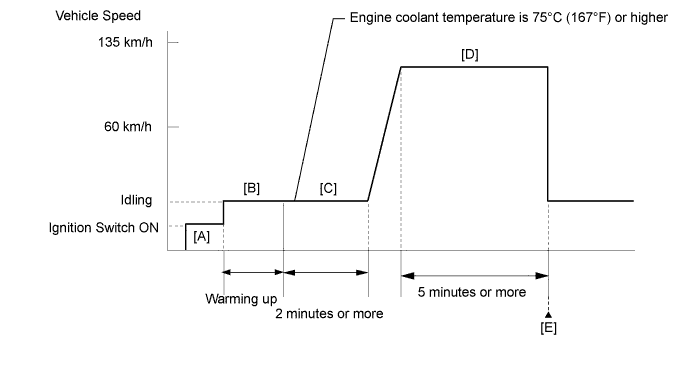
- Connect the intelligent tester to the DLC3.
- Turn the ignition switch to ON and turn the tester on.
- Clear the DTCs.
- Turn the ignition switch off and wait for at least 30 seconds.
- Turn the ignition switch to ON and turn the tester on [A].
- Start the engine and warm it up until the engine coolant temperature is 75°C (167°F) or higher with all the accessories switched off [B].
- With the engine warmed up, idle the engine for 2 minutes or more [C].
- Drive the vehicle at a speed between 60 and 135 km/h (38 and 85 mph) for 5 minutes or more [D].
- CAUTION:
- When performing the confirmation driving pattern, obey all speed limits and traffic laws.
- Enter the following menus: Powertrain / Engine and ECT / DTC [E].
- Read the Pending DTCs.
- HINT:
- If a pending DTC is output, the system is malfunctioning.
WIRING DIAGRAM
Refer to DTC P0100 (CAMRY_ACV40 RM000003SKB00XX_07.html).INSPECTION PROCEDURE
- HINT:
- Malfunctioning areas can be identified by performing the Control the Injection Volume for A/F Sensor function provided in the Active Test. The Control the Injection Volume for A/F Sensor function can help to determine whether the air fuel ratio sensor, heated oxygen sensor and other potential trouble areas are malfunctioning.
- The following instructions describe how to conduct the Control the Injection Volume for A/F Sensor operation using the intelligent tester.
- Connect the intelligent tester to the DLC3.
- Start the engine.
- Turn the tester on.
- Warm up the engine at an engine speed of 2500 rpm for approximately 90 seconds.
- Enter the following menus: Powertrain / Engine and ECT / Active Test / Control the Injection Volume for A/F Sensor.
- Perform the Active Test operation with the engine idling (press the RIGHT or LEFT button to change the fuel injection volume).
- Monitor the voltage outputs of the air fuel ratio and heated oxygen sensors (AFS Voltage B1S1 and O2S B1S2) displayed on the tester.
- HINT:
- The Control the Injection Volume for A/F Sensor operation lowers the fuel injection volume by 12.5% or increases the injection volume by 25%.
- Each sensor reacts in accordance with increases and decreases in the fuel injection volume.
| Tester Display (Sensor) | Injection Volume | Status | Voltage |
| AFS Voltage B1S1 (Air fuel ratio) | +25% | Rich | Less than 3.1 V |
| -12.5% | Lean | More than 3.4 V | |
| O2S B1S2 (Heated oxygen) | +25% | Rich | More than 0.55 V |
| -12.5% | Lean | Less than 0.4 V |
- NOTICE:
- The air fuel ratio sensor has an output delay of a few seconds and the heated oxygen sensor has a maximum output delay of approximately 20 seconds.
| Case | Air Fuel Ratio Sensor (Sensor 1) Output Voltage | Heated Oxygen Sensor (Sensor 2) Output Voltage | Main Suspected Trouble Area |
| 1 | 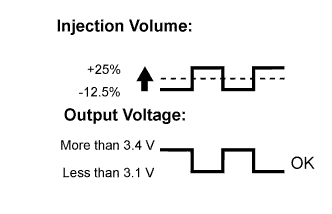 | 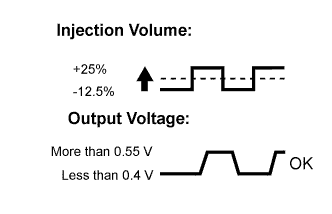 | - |
| 2 |  |  |
|
| 3 |  |  |
|
| 4 |  |  |
|
- Following the Control the Injection Volume for A/F Sensor procedure enables technicians to check and graph the voltage outputs of both the air fuel ratio and heated oxygen sensors.
- To display the graph, enter the following menus: Powertrain / Engine and ECT / Active Test / Control the Injection Volume for A/F Sensor / AFS Voltage B1S1 and O2S B1S2; then press the graph button on the Data List screen.
- NOTICE:
- Inspect the fuses for circuits related to this system before performing the following inspection procedure.
- HINT:
- Read freeze frame data using the intelligent tester. The ECM records vehicle and driving condition information as freeze frame data the moment a DTC is stored. When troubleshooting, freeze frame data can be helpful in determining whether the vehicle was running or stopped, whether the engine was warmed up or not, whether the air fuel ratio was lean or rich, as well as other data recorded at the time of a malfunction.
- A low air fuel ratio sensor voltage could be caused by a rich air fuel mixture. Check for conditions that would cause the engine to run rich.
- A high air fuel ratio sensor voltage could be caused by a lean air fuel mixture. Check for conditions that would cause the engine to run lean.
- Sensor 1 refers to the sensor closest to the engine assembly.
- Sensor 2 refers to the sensor farthest away from the engine assembly.
| 1.CHECK ANY OTHER DTCS OUTPUT (IN ADDITION TO DTC P0171 OR P0172) |
Connect the intelligent tester to the DLC3.
Turn the ignition switch to ON.
Turn the tester on.
Enter the following menus: Powertrain / Engine and ECT / DTC.
Read the DTCs.
- Result:
Result Proceed to DTC P0171 or P0172 is output A DTC P0171 or P0172 and other DTCs are output B
- HINT:
- If any DTCs other than P0171 or P0172 are output, troubleshoot those DTCs first.
|
| ||||
| A | |
| 2.CHECK PCV HOSE CONNECTIONS |
Check the PCV hose connections.
- OK:
- PCV hose is connected correctly and is not damaged.
|
| ||||
| OK | |
| 3.CHECK INTAKE SYSTEM |
Check the intake system for vacuum leaks.
- OK:
- No leaks in intake system.
|
| ||||
| OK | |
| 4.PERFORM ACTIVE TEST USING INTELLIGENT TESTER (CONTROL THE INJECTION VOLUME) |
Connect the intelligent tester to the DLC3.
Start the engine.
Turn the tester on.
Warm up the engine at an engine speed of 2500 rpm for approximately 90 seconds.
Enter the following menus: Powertrain / Engine and ECT / Active Test / Control the Injection Volume / All Data / AFS Voltage B1S1 and O2S B1S2.
Perform the Control the Injection Volume operation with the engine idling.
Monitor the voltage outputs of the air fuel ratio sensor and the heated oxygen sensor (AFS Voltage B1S1 and O2S B1S2) displayed on the tester.
- HINT:
- Change the fuel injection volume within the range of -12.0% and +12.0%. The injection volume can be changed in fine gradations.
- The air fuel ratio sensor has an output delay of a few seconds and the heated oxygen sensor has a maximum output delay of approximately 20 seconds.
- Standard:
Tester Display
(Sensor)Injection Volume Status Voltage AFS Voltage B1S1
(Air fuel ratio)+12% Rich Less than 3.1 V -12% Lean More than 3.4 V O2S B1S2
(Heated oxygen)+12% Rich More than 0.55 V -12% Lean Less than 0.4 V
Lean: During the Control the Injection Volume Active Test, the air fuel ratio sensor output voltage (AFS Voltage B1S1) is consistently more than 3.4 V, and the heated oxygen sensor output voltages (O2S B1S2) is consistently less than 0.4 V.Result Status
AFS Voltage B1S1Status
O2S B1S2Air Fuel Ratio Condition and
Air Fuel Ratio Sensor ConditionMisfire Suspected Trouble Area Proceed to Lean/Rich Lean/Rich Normal - - A Lean Lean Actual air fuel ratio lean May occur - PCV valve and hose
- PCV hose connections
- Fuel injector assembly blockage
- Gas leak from exhaust system
- Intake system
- Fuel pressure
- Mass air flow meter sub-assembly
- Engine coolant temperature sensor
A Rich Rich Actual air fuel ratio rich - - Fuel injector assembly blockage
- Gas leak from exhaust system
- Ignition system
- Fuel pressure
- Mass air flow meter sub-assembly
- Engine coolant temperature sensor
Lean Lean/Rich Air fuel ratio sensor malfunction - Air fuel ratio sensor B Rich Lean/Rich Air fuel ratio sensor malfunction - Air fuel ratio sensor
Rich: During Control the Injection Volume of the Active Test, the AFS Voltage B1S1 is consistently less than 3.1 V, and the O2S B1S2 is consistently more than 0.55 V.
Lean/Rich: During the Control the Injection Volume Active Test, the output voltage of the heated oxygen sensor alternates correctly.- HINT:
- Refer to Data List / Active Test [AFS Voltage B1S1 and O2S B1S2] (CAMRY_ACV40 RM000000PDN0GRX.html).
|
| ||||
| A | |
| 5.READ VALUE USING INTELLIGENT TESTER (COOLANT TEMP) |
Connect the intelligent tester to the DLC3.
Turn the ignition switch to ON.
Turn the tester on.
Enter the following menus: Powertrain / Engine and ECT / Data List / All Data / Coolant Temp.
Read the Coolant Temp twice, when the engine is both cold and warmed up.
- Standard value:
- With cold engine:
Same as ambient air temperature.
With warm engine:
Between 75°C and 100°C (176°F and 212°F).
|
| ||||
| OK | |
| 6.READ VALUE USING INTELLIGENT TESTER (MAF) |
Connect the intelligent tester to the DLC3.
Turn the ignition switch to ON.
Turn the tester on.
Enter the following menus: Powertrain / Engine and ECT / Data List / All Data / MAF and Coolant Temp.
Allow the engine to idle until Coolant Temp reaches 75 °C (167°F) or higher.
Read the MAF with the engine in an idling condition and at an engine speed of 2500 rpm.
- Standard:
- Between 6 g/sec. and 10 g/sec. (shift position: N, A/C: OFF).
|
| ||||
| OK | |
| 7.CHECK FUEL PRESSURE |
Check the fuel pressure (CAMRY_ACV40 RM000000YCR00RX_01_0002.html).
- Standard pressure:
- 304 to 343 kPa (3.1 to 3.5 kgf/cm2, 44.1 to 49.7 psi)
|
| ||||
| OK | |
| 8.CHECK FOR EXHAUST GAS LEAK |
Check for exhaust gas leaks.
- OK:
- No gas leaks.
|
| ||||
| OK | |
| 9.CHECK FOR SPARKS AND IGNITION |
Check the sparks and ignition (CAMRY_ACV40 RM000001QVP03SX_01_0001.html).
|
| ||||
| OK | |
| 10.INSPECT FUEL INJECTOR ASSEMBLY (INJECTION AND VOLUME) |
Check the injection and volume (CAMRY_ACV40 RM000000YCT00PX_01_0001.html).
- Standard injection volume:
- 76 to 92 cm3 (4.6 to 5.6 cu in.) per 15 seconds
|
| ||||
|
| ||||
| 11.INSPECT AIR FUEL RATIO SENSOR (HEATER RESISTANCE) |
Disconnect the air fuel ratio sensor connector.
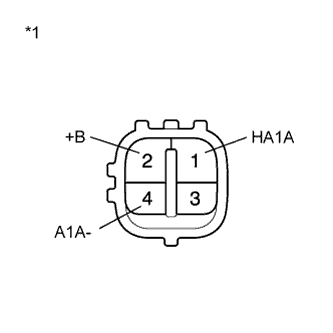 |
Measure the resistance according to the value(s) in the table below.
- Standard Resistance:
Tester Connection Condition Specified Condition 1 (HA1A) - 2 (+B) 20°C (68°F) 1.8 to 3.4 Ω 1 (HA1A) - 4 (A1A-) Always 10 kΩ or higher
Text in Illustration *1 Component without harness connected
(Air Fuel Ratio Sensor)
Reconnect the air fuel ratio sensor connector.
|
| ||||
| OK | |
| 12.CHECK TERMINAL VOLTAGE (POWER SOURCE OF AIR FUEL RATIO SENSOR) |
Disconnect the air fuel ratio sensor connector.
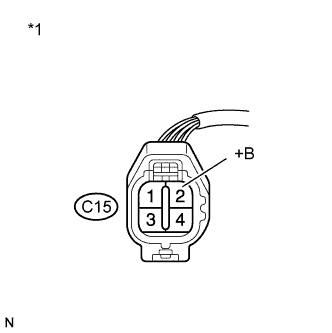 |
Turn the ignition switch to ON.
Measure the voltage according to the value(s) in the table below.
- Standard Voltage:
Tester Connection Switch Condition Specified Condition C15-2 (+B) - Body ground Ignition switch ON 11 to 14 V
Text in Illustration *1 Front view of wire harness connector
(to Air Fuel Ratio Sensor)
Reconnect the air fuel ratio sensor connector.
|
| ||||
| OK | |
| 13.CHECK HARNESS AND CONNECTOR (AIR FUEL RATIO SENSOR - ECM) |
Disconnect the air fuel ratio sensor connector.
Disconnect the ECM connector.
Measure the resistance according to the value(s) in the table below.
- Standard Resistance (Check for Open):
Tester Connection Condition Specified Condition C15-1 (HA1A) - C24-109 (HA1A) Always Below 1 Ω C15-3 (A1A+) - C24-112 (A1A+) Always Below 1 Ω C15-4 (A1A-) - C24-113 (A1A-) Always Below 1 Ω
- Standard Resistance (Check for Short):
Tester Connection Condition Specified Condition C15-1 (HA1A) or C24-109 (HA1A) - Body ground Always 10 kΩ or higher C15-3 (A1A+) or C24-112 (A1A+) - Body ground Always 10 kΩ or higher C15-4 (A1A-) or C24-113 (A1A-) - Body ground Always 10 kΩ or higher
Reconnect the air fuel ratio sensor connector.
Reconnect the ECM connector.
|
| ||||
| OK | |
| 14.REPLACE AIR FUEL RATIO SENSOR |
Replace the air fuel ratio sensor (CAMRY_ACV40 RM0000012OI006X.html).
| NEXT | |
| 15.PERFORM CONFIRMATION DRIVING PATTERN |
Connect the intelligent tester to the DLC3.
Turn the ignition switch to ON and turn the tester on.
Clear the DTCs (CAMRY_ACV40 RM000000PDK0LEX.html).
Turn the ignition switch off.
Turn the ignition switch to ON and turn the tester on.
Start the engine and warm it up.
Drive the vehicle in accordance with the driving pattern described in the Confirmation Driving Pattern.
Enter the following menus: Powertrain / Engine and ECT / DTC.
Read the pending DTCs.
- Result:
Result Proceed to DTC P0171 or P0172 is output A DTC is not output B
|
| ||||
| A | |
| 16.CHECK HARNESS AND CONNECTOR |
Check the connection and terminal contact pressure of connectors and wire harnesses between the mass air flow meter and ECM (CAMRY_ACV40 RM000000UZ301ZX.html).
- HINT:
- Repair any problems.
| NEXT | |
| 17.CHECK WHETHER DTC OUTPUT RECURS (DTC P0171 OR P0172) |
Connect the intelligent tester to the DLC3.
Turn the ignition switch to ON.
Turn the tester on.
Clear the DTCs (CAMRY_ACV40 RM000000PDK0LEX.html).
Turn the ignition switch off.
Turn the ignition switch to ON and turn the tester on.
Start the engine and warm it up.
Drive the vehicle in accordance with the driving pattern described in the Confirmation Driving Pattern.
Enter the following menus: Powertrain / Engine and ECT / DTC.
Read the Pending DTCs.
- Result:
Result Proceed to DTC P0171 or P0172 is output A DTC is not output B
|
| ||||
| A | |
| 18.CHECK HARNESS AND CONNECTOR (MASS AIR FLOW METER - ECM) |
Disconnect the mass air flow meter connector.
Disconnect the ECM connector.
Measure the resistance according to the value(s) in the table below.
- Standard Resistance (Check for Open):
Tester Connection Condition Specified Condition C2-5 (VG) - C24-118 (VG) Always Below 1 Ω C2-4 (E2G) - C24-116 (E2G) Always Below 1 Ω
- Standard Resistance (Check for Short):
Tester Connection Condition Specified Condition C2-5 (VG) or C24-118 (VG) - Body ground Always 10 kΩ or higher
Reconnect the mass air flow meter connector.
Reconnect the ECM connector.
|
| ||||
| OK | |
| 19.REPLACE MASS AIR FLOW METER |
Replace the mass air flow meter (CAMRY_ACV40 RM000002A3Z001X.html).
- HINT:
- If the result of the inspection performed in step 6 indicated no problem, proceed to the next step without replacing the mass air flow meter.
| NEXT | |
| 20.CHECK WHETHER MALFUNCTION HAS BEEN SUCCESSFULLY REPAIRED |
Connect the intelligent tester to the DLC3.
Turn the ignition switch to ON.
Turn the tester on.
Clear the DTCs (CAMRY_ACV40 RM000000PDK0LEX.html).
Turn the ignition switch off.
Turn the ignition switch to ON and turn the tester on.
Start the engine and warm it up.
Drive the vehicle in accordance with the driving pattern described in the Confirmation Driving Pattern.
Enter the following menus: Powertrain / Engine and ECT / DTC.
Read the Pending DTCs.
- Result:
Result Proceed to DTC P0171 or P0172 is output A DTC is not output B
|
| ||||
| A | ||
| ||